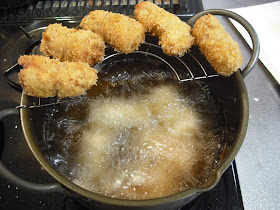As part of supper tonight, I made daikon rolled with meat and other deep-fried items.
今日の夕飯には、大根の肉巻きと他の揚げ物を作りました。
First, a photo of snow on the road just in front of my house yesterday morning:
まずは、昨日の朝、家のすぐ前の道の雪:
I "roasted" some of the hatomugi (Job's Tears) given by my father in the toaster oven.
父からもらったはと麦を少し、オーブントースターで「煎り」ました。
That's another story.
別の話ですが。
I made "sweet potato" with a little help from my daughter.
「スイートポテト」を作りました。娘が少し手伝ってくれました。
That's another story, too.
これも別の話です。
Make ten sheets of daikon measuring approx. 10 x 8 x 0.3 cm. Put them in a bowl, add some (1 tsp salt) salt, rub well, and let stand. Roll each sheet with a thin slice of pork.
約10 x 8 x 0.3 cmの薄い大根のシートを作ります。ボールに入れ、塩を少々(小さじ1)入れ、よくもみ、放置します。各シートを豚の薄切りと一緒に巻きます。
I know that my children wouldn't be satisfied with the niku maki alone, so I made french fries (called fried potato in japanese), too.
子供たちは肉巻きだけでは満足しないと分かっているので、フライドポテトも作りました。
And, meat balls, too.
それから、肉団子も。
Ground pork + grated ginger + one egg + potato starch + some salt
豚の挽き肉+おろし生姜+卵1個+片栗粉+塩少々
Sprinkle some pepper (but no salt, because the daikon sheets are already salted) on the rolls, dust with flour, coat with beaten egg, and coat with panko.
胡椒をかけ(塩はかけません。大根に塩味がついているので)、小麦粉をつけ、溶き卵をつけ、パン粉をつけます。
Deep-fry for 3-4 min. at 180C.
180Cで3~4分、揚げます。
I had mine with tonkatsu sauce and lemon juice.
私は豚カツソースとレモンジュースで食べました。
Yummy!
美味しかったです!









Hi, Out of curiosity I had peeped into your blog. I hardly know about Japanese cusine, and wanted to explore it. Most of the names are new to me, but Job'tears, looked very nice indeed.
ReplyDeleteHiroyuki both the rolls and the balls look terrific! (not to mention the fried potatoes). Your making-of photos are excellent!
ReplyDeleteIt's the first time I read about Job's Tears, so I have checked it at wikipedia. Apparently it is used in Japan to make vinegar. Is it true? I am very curious about what you will do with it!
gardenerat60: Thanks for peeing into my blog from India! I'm sure that there are other wonderful blogs and sites on Japanese cuisine that will interest you. Come to my blog if you want to see ordinary, sometimes somewhat mediore Japanese dishes!
ReplyDeleteSissi: You can make vinegar from fruits including persimmons and grains including hatomugi, but I just wanted to make hatomugi cha (= tea), similar to mugi cha (barley tea).
ReplyDeleteThank you! It sounds very intriguing!
ReplyDeleteBeautiful snow!!!! I don't see a lot of it in Texas. I do need to find a frying pot like the one you have, I fry very infrequently, but it would still be nice to have.
ReplyDeletemuskratbyte: A cast iron pot especially for deep-frying is something you will want to have if you want to make decent tempura, tonkatsu, and other deep-fried items.
ReplyDeleteNo one here likes snow, except children...
Hiroyuki-san
ReplyDeleteI am very interested to see that you have hatomugi! I understand that it is often made into a beverage or sometimes eaten in the yuuki form by people following a macrobiotic diet. How did you use it?
I would like to try growing this plant in the UK. Although our climate is quite cold, the ornamental variety which we call Job's tears generally grows quite well. Do you know it is possible to purchase small qauntities of seeds of hatomugi varieties from northern Japan? I hear that some good ones grow in Hokkaido.
Rhizowen: I just used it to make tea.
ReplyDeleteHatomugi is often cooked with rice, as you say, but I don't have the necessary equipment.
Sorry, I don't know the availability of Japanese hatomugi varieties in your country. I did some googling and found that the variety "Okhotsk 1 Go" can be grown in Southern Hokkaido.
Thanks Hiroyuki
ReplyDeleteI'll investigate further that variety.
There are some people in UK growing Japanese vegetables for sale commercially. I haven't visited, but maybe one day when I'm in the area I will
http://www.namayasai.co.uk/
Rhizowen: Thanks for the link.
ReplyDeleteI think your investigation will be facilitated by sending an inquiry to that firm.
Anyway, I hope you find your hatomugi seeds soon!